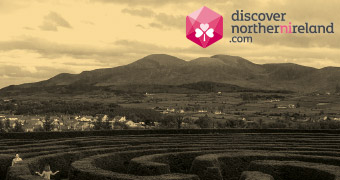From the Northern Whig, 12 August 1901 in Sydney Matier’s album from PRONI
In August 1901, a reporter named ‘R.B.’ from the Northern Whig newspaper, based in Belfast took a trip around Mourne in a day long bus tour. He had the ‘good fortune to secure a seat on one of the Messrs. Norton and Co’s highland coaches’ giving him the ‘privilege and pleasure of a trip through the Mourne Mountains, to the beautiful and enchanting lake Lough Shannagh and to the Happy Valley.’ Something which much impressed him was the scenery which was not ‘unadorned and marred by man’.
The trip was organised by the superintendent of Messrs. Norton and Co’s car service. They supplied two well appointed and comfortable highland coaches which accommodated 30 ladies and gentlemen from various parts of England and Ireland.
They started their journey at the car office in Kilkeel which was just beside the Courthouse, leaving at 10am on a beautiful and clear day. They travelled up the Newry Road where they passed Mourne Park, the ‘charming residence’ of the Earl of Kilmorey where they were able to admire Carlingford Lough and Greencastle Castle, along with the old Bridge at White Water River.
They continued up along the Tullyframe Road where the landscape was dotted with woods, there coming to the conclusion that ‘I do not know a more interesting district’. On the Tullyframe Road the bus was ‘greeted with loud cheers of welcome from the many farmers and labourers…pulling their flax’.
Apparently a local farmer named ‘Edward Ned’ waved his hat frantically at the visitors while’ Pat Bradley’ wished them a pleasant day. The author writes that the coaches containing so many people was a ‘novel sight’ and that men would rest from their work and women and children would rush from their cottages looking at them with ‘mingled admiration and curiosity’.
The buses then passed along the base of Eagle Rock Mountains where he was told a golden eagle supposedly visited for several days during the month of June last. Attical Chapel then came into view. The area itself was described as ‘pretty with clean homely cottages’. They passed up the valley to Moyadd where they left for a mountain walk and proposed having their lunch at Lough Shannagh. The people on the trip were ‘charmed by the various views’ amid the laughter and jokes echoing from the surrounding mountains.
The reached Lough Shannagh and were taken aback by the ‘silvery sands’ of its beach and decided to have their lunch as it was nearing noon. After this they made a start for the Happy Valley, surrounded by bright green pastures and great expanses of purple heather. They heard a cock crow in the distance and as if ‘by magic’ the whole mountains lit up in the sunlight as they walked towards the valley. When the Happy Valley came into view surrounded by the mountains ‘the great stillness of the valley was here apparent’. Before they left the valley, they saw a shepherd herding his sheep on the near hills. As they proceeded down the valley, they began to near the ‘busy haunts of man, by the noise of one of the Messrs. Fisher and Le Fanu’s locomotives proceeding down the railway line’ loaded with sand for work in connection with the Belfast Water Scheme. Their coaches were waiting for them at the valley gates and they drove down Carginagh Road to Kilkeel where they arrived at around 5pm.
Those present on the tour were ‘greatly charmed by the day’s outings’ and ‘many of the party will have pleasant memories of their visit to the lovely little lake nestling in the bosom of the Mourne Mountains’.
This article gives us a glimpse into the world of Mourne in the late 19th and early 20th Centuries. It was obviously a popular tourist destination even then, with people wanting to visit the much famed Kingdom of Mourne. It was perhaps even more beautiful and peaceful back in this era. The people on the coach trip are stunned by the natural beauty of the area and the author almost makes it seem like a magical place to visit, using the colourful and emotive language throughout his piece. It seems like a different world,from the farmers in the fields gathering flax next to their little cottages nestled in the hills, to the shepherd on the hills with the train running through the Happy Valley in the background



